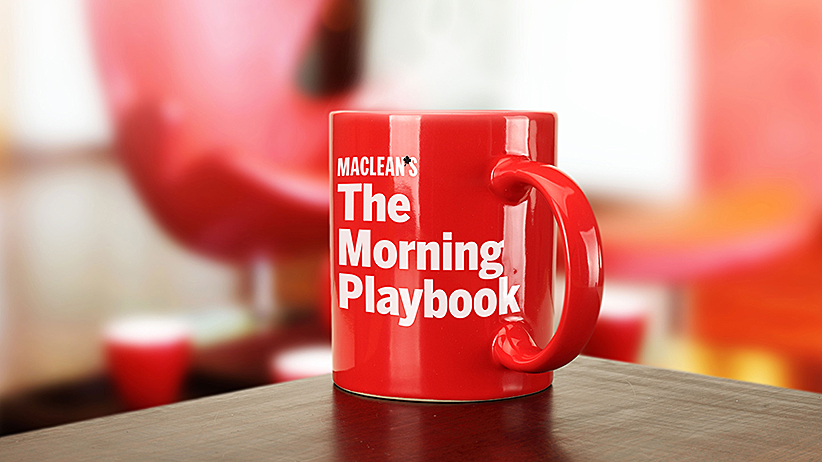Failed banking stress tests and a bleak spring for Ukraine
March 12: Plus, as the euro bounces back and the greenback slows down, is a calmer day ahead for world currencies?
Share
Are there calmer shores ahead?
On Tuesday, major currency moves between the dollar and the euro – as the ECB’s asset-buying program kicked in and a strong jobs report gave weight to questions about when the Fed will hike interest rates – pushed the euro down and the dollar up, and spurred equity sell-offs around the world. But today, European markets have turned around, with one European index hitting a seven-year high – led by commodity stocks. Yesterday, the TSX/S&P Composite Index pared back (some) of the previous days three-digit losses, closing almost 100 points up on a turnaround in gold and oil prices. Meanwhile, the loonie sunk further, closing down half a cent after hitting a six-year low earlier in the day.
What to watch for today? In Canada, yet another chance to speculate on how much the housing market is overvalued, with the new housing price index for January, as well as fourth-quarter numbers on capacity, and the national balance sheet and financial flow account. In the U.S., retail numbers will be watched closely for signs of how the job market is feeding into consumption, and the eurozone will also look for bright signs in the latest industrial production numbers.
Two banks fail U.S. stress tests. Deutsche Bank and Santander both failed the second round of the Fed’s bank stress tests, a qualitative test that looks at how banks manage issues around capital planning and risk during scenarios of financial stress. This is the second time Santander, a Spanish bank, has failed the stress test, and the first time Deutsche Bank has been tested. However, there were other notable mentions: Bank of America’s pass was “conditional,” while several other banks – Goldman Sachs, JPMorgan Chase and Morgan Stanley – had to make adjustments to their plans in order to pass. Last week the Fed released the results of the first round of tests, which are quantitative tests to check that major banks have enough money to keep operating under various financial-crisis scenarios. All 31 banks passed that first set – the first time all the banks have passed since 2009. The tests have major consequences, as failing the first set can mean not being able to buy back shares or raise dividends.
A big change for Hydro One. As the Ontario government draws up plans to privatize part of the province’s utility company, the Globe reports that a few different bodies are looking for an opportunity: the province’s municipal pension fund and two electricity distributors, Enersouce Corp. and PowerStream Inc. All appear to be looking at opportunities for mergers in the utility industry. Kathleen Wynne’s government is weighing two options for privatization, the Globe says: a system where distribution channels would be sold while transmission operations remain public, or an IPO that would keep the Hydro One as a single entity.
A bleak spring for Ukraine. The IMF has approved a $17.5-billion loan for the country, which has seen its currency drop dramatically and its economy contract. The Ukrainian government says GDP could contract almost 12 per cent this year alone, and cash reserves are at just $6 billion. Earlier this month, the central bank hiked the interest rate to 30 per cent, the world’s highest, to keep the hryvnia from losing more value: it has already lost 80 per cent of its worth this year, the BBC reports, with prices expected to rise by more than 25 per cent this year. The Ukrainian president recently said the war has cost the country as much as 20 per cent of its productivity. The IMF money is intended to go toward structural economic reforms, but is unlikely to be the last dose.
When Alibaba met Snapchat. The FT is reporting the Chinese e-commerce giant is investing $200 million in Snapchat – the app best known for letting you send pictures to people that then immediately disappear. The investment is expected to push the company’s valuation up to $15 billion, a 50 per cent increase from the beginning of the year. The Chinese company has been investing in lots of U.S. tech companies lately, including Lyft, an Uber competitor, but has said its focus is currently on investing in China. Snapchat, for its part, has been expanding beyond those one-time pictures. They’ve been branching into “storytelling” partnerships with major media companies including CNN and Vice, which, CNN insists, does actually make sense.
That old Tim Hortons metaphor. If there was ever one symbol of the fortunes of Alberta’s Fort McMurray, surely it is the local Timmies, just off Highway 63. At least according to visiting journalists, that is, both from outlets both very near and very far. And one thing none of them are getting is an interview with the people in charge: “The journalist will soon find, unfortunately, that gaining an audience with the Pope might be easier than talking to the local Tim Hortons shift supervisor.” In this CBC take on the Tim Hortons business-journalism trope – lazy cliché or uniquely Canadian economic indicator? – a look at all the ways the local donut shop has been used to symbolize northern Alberta’s booms, and busts.
Need to know:
TSX: 14,739.20 (+97.44), Wednesday
Loonie: 78.36 (-0.5 cents), Wednesday
Oil (WTI): $48.46, Thursday (7:30 a.m.)
